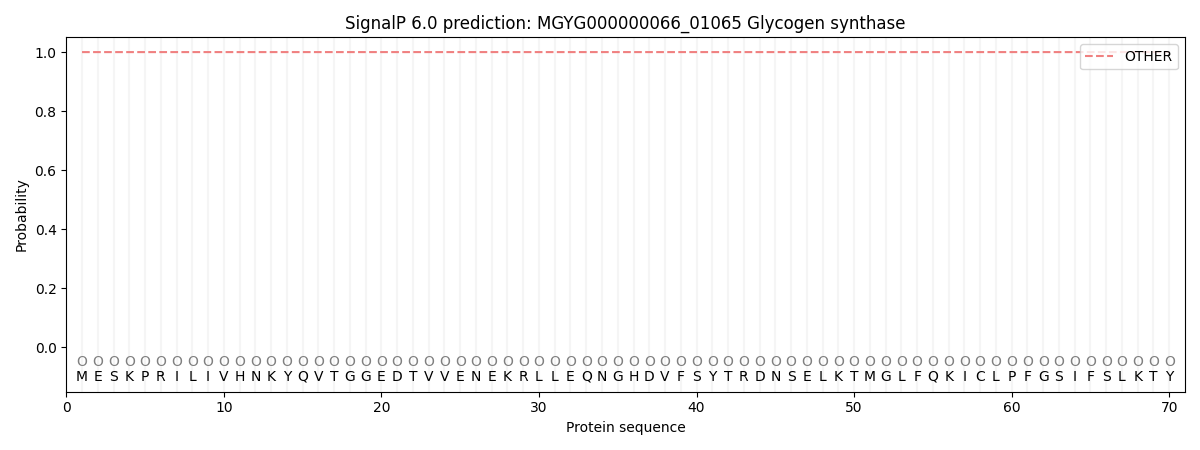You are browsing environment: HUMAN GUT
CAZyme Information: MGYG000000066_01065
You are here: Home > Sequence: MGYG000000066_01065
Basic Information |
Genomic context |
Full Sequence |
Enzyme annotations |
CAZy signature domains |
CDD domains |
CAZyme hits |
PDB hits |
Swiss-Prot hits |
SignalP and Lipop annotations |
TMHMM annotations
Basic Information help
| Species | GCA-900066755 sp900066755 | |||||||||||
|---|---|---|---|---|---|---|---|---|---|---|---|---|
| Lineage | Bacteria; Firmicutes_A; Clostridia; Lachnospirales; Lachnospiraceae; GCA-900066755; GCA-900066755 sp900066755 | |||||||||||
| CAZyme ID | MGYG000000066_01065 | |||||||||||
| CAZy Family | GT4 | |||||||||||
| CAZyme Description | Glycogen synthase | |||||||||||
| CAZyme Property |
|
|||||||||||
| Genome Property |
|
|||||||||||
| Gene Location | Start: 171240; End: 172454 Strand: - | |||||||||||
CDD Domains download full data without filtering help
| Cdd ID | Domain | E-Value | qStart | qEnd | sStart | sEnd | Domain Description |
|---|---|---|---|---|---|---|---|
| cd03801 | GT4_PimA-like | 5.24e-41 | 6 | 395 | 1 | 365 | phosphatidyl-myo-inositol mannosyltransferase. This family is most closely related to the GT4 family of glycosyltransferases and named after PimA in Propionibacterium freudenreichii, which is involved in the biosynthesis of phosphatidyl-myo-inositol mannosides (PIM) which are early precursors in the biosynthesis of lipomannans (LM) and lipoarabinomannans (LAM), and catalyzes the addition of a mannosyl residue from GDP-D-mannose (GDP-Man) to the position 2 of the carrier lipid phosphatidyl-myo-inositol (PI) to generate a phosphatidyl-myo-inositol bearing an alpha-1,2-linked mannose residue (PIM1). Glycosyltransferases catalyze the transfer of sugar moieties from activated donor molecules to specific acceptor molecules, forming glycosidic bonds. The acceptor molecule can be a lipid, a protein, a heterocyclic compound, or another carbohydrate residue. This group of glycosyltransferases is most closely related to the previously defined glycosyltransferase family 1 (GT1). The members of this family may transfer UDP, ADP, GDP, or CMP linked sugars. The diverse enzymatic activities among members of this family reflect a wide range of biological functions. The protein structure available for this family has the GTB topology, one of the two protein topologies observed for nucleotide-sugar-dependent glycosyltransferases. GTB proteins have distinct N- and C- terminal domains each containing a typical Rossmann fold. The two domains have high structural homology despite minimal sequence homology. The large cleft that separates the two domains includes the catalytic center and permits a high degree of flexibility. The members of this family are found mainly in certain bacteria and archaea. |
| COG0438 | RfaB | 3.68e-33 | 6 | 402 | 2 | 381 | Glycosyltransferase involved in cell wall bisynthesis [Cell wall/membrane/envelope biogenesis]. |
| cd03823 | GT4_ExpE7-like | 2.77e-31 | 6 | 399 | 1 | 355 | glycosyltransferase ExpE7 and similar proteins. This family is most closely related to the GT4 family of glycosyltransferases. ExpE7 in Sinorhizobium meliloti has been shown to be involved in the biosynthesis of galactoglucans (exopolysaccharide II). |
| cd03808 | GT4_CapM-like | 6.91e-24 | 6 | 392 | 1 | 358 | capsular polysaccharide biosynthesis glycosyltransferase CapM and similar proteins. This family is most closely related to the GT4 family of glycosyltransferases. CapM in Staphylococcus aureus is required for the synthesis of type 1 capsular polysaccharides. |
| pfam00534 | Glycos_transf_1 | 2.84e-23 | 226 | 378 | 1 | 154 | Glycosyl transferases group 1. Mutations in this domain of PIGA lead to disease (Paroxysmal Nocturnal haemoglobinuria). Members of this family transfer activated sugars to a variety of substrates, including glycogen, Fructose-6-phosphate and lipopolysaccharides. Members of this family transfer UDP, ADP, GDP or CMP linked sugars. The eukaryotic glycogen synthases may be distant members of this family. |
CAZyme Hits help
| Hit ID | E-Value | Query Start | Query End | Hit Start | Hit End |
|---|---|---|---|---|---|
| AWI06387.1 | 9.79e-128 | 4 | 398 | 3 | 388 |
| VCV20896.1 | 1.07e-127 | 4 | 402 | 3 | 399 |
| CBL13767.1 | 1.22e-127 | 4 | 402 | 7 | 403 |
| CBL07750.1 | 2.14e-127 | 4 | 402 | 3 | 399 |
| AEN97570.1 | 1.51e-126 | 6 | 395 | 5 | 392 |
Swiss-Prot Hits download full data without filtering help
| Hit ID | E-Value | Query Start | Query End | Hit Start | Hit End | Description |
|---|---|---|---|---|---|---|
| P26470 | 8.46e-07 | 224 | 361 | 190 | 337 | Lipopolysaccharide 1,2-N-acetylglucosaminetransferase OS=Salmonella typhimurium (strain LT2 / SGSC1412 / ATCC 700720) OX=99287 GN=waaK PE=3 SV=1 |
| Q65CC7 | 1.51e-06 | 217 | 398 | 197 | 384 | Alpha-D-kanosaminyltransferase OS=Streptomyces kanamyceticus OX=1967 GN=kanE PE=1 SV=1 |
| Q8CWR6 | 3.96e-06 | 8 | 327 | 5 | 311 | Alpha-monoglucosyldiacylglycerol synthase OS=Streptococcus pneumoniae (strain ATCC BAA-255 / R6) OX=171101 GN=spr0982 PE=1 SV=1 |
| A0QQZ8 | 5.19e-06 | 181 | 368 | 183 | 375 | D-inositol 3-phosphate glycosyltransferase OS=Mycolicibacterium smegmatis (strain ATCC 700084 / mc(2)155) OX=246196 GN=mshA PE=1 SV=1 |
SignalP and Lipop Annotations help
This protein is predicted as OTHER

| Other | SP_Sec_SPI | LIPO_Sec_SPII | TAT_Tat_SPI | TATLIP_Sec_SPII | PILIN_Sec_SPIII |
|---|---|---|---|---|---|
| 1.000005 | 0.000033 | 0.000002 | 0.000000 | 0.000000 | 0.000000 |
